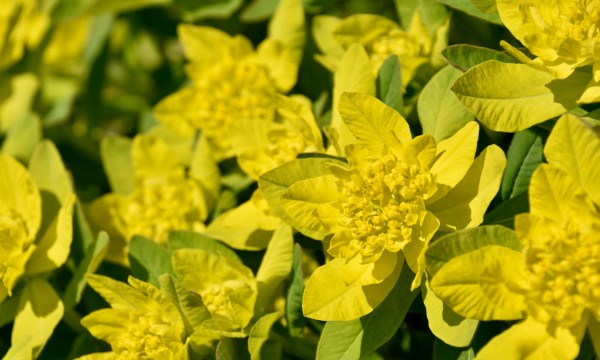Producing long-lasting flower-like bracts above handsome foliage, euphorbias are virtually trouble-free plants for any sunny garden. Here are some helpful hints for selecting, planting and growing this low-maintenance plant.
- Browse Categories
- All Tips
-
Home & Garden
- All
- Appliances
- Bathroom
- Cleaning
- Crafts
- Decorating
- Electrical
- Flooring
- Furniture
- Garage Door
- Gardening
- Green Living
- Heating
- Home Alarm Systems
- Home Maintenance
- Home Remedies
- Home Security
- Home Staging
- House Sitting
- Junk Removal
- Kitchen
- Lawn Care
- Lock Systems
- Moving
- Outdoor Living
- Pest Control
- Plumbing
- Renovation
- Roofing
- Snow Removal
- Storage
- Tools
- Tree Service
- Health
- Family
- Travel
- Auto
- More Tips

How to select, plant and grow trouble-free euphorbias
October 9, 2015

Also known as spurge, euphorbias grow into mounds of green, bronze, or golden leaves ranging in height from 0.3 to 1.8 metres (one to six feet). While it's a lovely foliage plant, it's even better when outfitted with colourful button-like bracts in spring, which are actually modified leaves at the base of the inconspicuous flowers.
Besides being well-behaved garden subjects that combine easily with other perennials, euphorbias practically thrive on neglect.
- In fact, euphorbias are known to adapt to poor soil, tolerate drought extremely well and appear impervious to pests and diseases
Things to watch out for
Although they are essentially care-free, euphorbias do require careful handling.
- The same milky sap that deters pests can potentially cause allergic skin reactions in some people. That's why it's best to wear gloves when handling the plants.
- Carefully use a flame (such as from a match or lighter) to promptly sear and seal the ends of stems gathered for cut-flower arrangements.
Caring for euphorbia
You can grow cushion spurge from seed, but seedlings need three years to develop into mature clumps. It's faster to begin with purchased plants.
- Set them out in early spring and give them sun in cool-summer regions and partial shade in warmer climates.
- As long as the site is well-drained, the soil need not be extremely fertile.
Starter plants have sparse roots and benefit from supplemental watering to keep the soil barely moist for two months or so after planting.
- In subsequent seasons, fertilize plants each spring with an organic or controlled-release fertilizer applied according to directions on the label.
- If plants look messy after flowering, trim them back to half their size, and they will produce compact new growth.
Increase the bounty
Although euphorbias can be left alone for decades and will thrive on their own, you can dig and divide the plants as often as every three years to propagate it. When dividing, it's important to remember you should:
- Dig clumps as soon as the first shoots poke through the soil in early spring.
- Cut the roots into thirds or fourths with a sharp knife and promptly replant them.
Consider the colour
Euphorbias feature fascinating variations in colour and texture:
- Cushion spurge Euphorbia polychrome (Zone 4) covers itself with bright chartreuse flower bracts in spring, and its soft green foliage turns red in fall. A stone wall or weathered wooden fence as a background sets it off perfectly. It grows about 30 centimetres (one foot) tall and is perfect for planting in containers.
- Equally well-behaved is the slightly taller E. dulcis 'Chameleon' (Zone 8), which has purple foliage topped by 45-cm (18-in.) tall spikes of chartreuse flower bracts in early summer.
- The airy sprays of white bracts produced by E. corollata (Zone 5), or flowering spurge, resemble baby's breath, but these plants are easier to grow in poor, heavy soil and are slow to spread.
- A good choice for the centre of a border is E. griffithii (Zone 4), with narrow leaves tinged red when young, and orange-red bracts in early summer.
- In comparison, 'Dixter' has copper-tinted foliage and darker flower heads.
Many varieties of euphorbia grow well not only as indoor plants, but also outdoors in containers.
The size of the container will determine how many plants you can include per container, however mixing varieties of euphorbia means you need to water less.
- Although euphorbia doesn't require a lot of water, plant them in a container that has at least one drainage hole at the bottom.
Euphorbia at-a-glance
Attributes
Chartreuse flower bracts on mounded plants; red fall foliage; perfect for beds and containers.
Season of interest
Spring through fall.
Popular varieties
Cushion spurge; E. dulcis 'Chameleon' flowering spurge, E. griffithii.
Quirk
Milky sap can potentially irritate skin on contact.
Good neighbours
Campanula, coreopsis, iris, larkspur, marigolds, peony, yarrow.
Best growing conditions
Sun to partial shade; average to infertile, well-drained soil.
Potential problems
Foliage can be damaged if grown in full sun in hotter climates.
Renewing plants
Plants live for years; divide clumps in early spring.
Pest and disease resistance
Excellent.
Dimensions
Usually between 0.3 to 1.8 m (1 to 6 ft.) tall and wide.
Low-maintenance euphorbias are a desirable addition to practically any garden. Although they're not the flashiest flowers around, their unique leaves, extreme hardiness and interesting profile make them visually attractive and appealing to grow in and around your home and garden.






